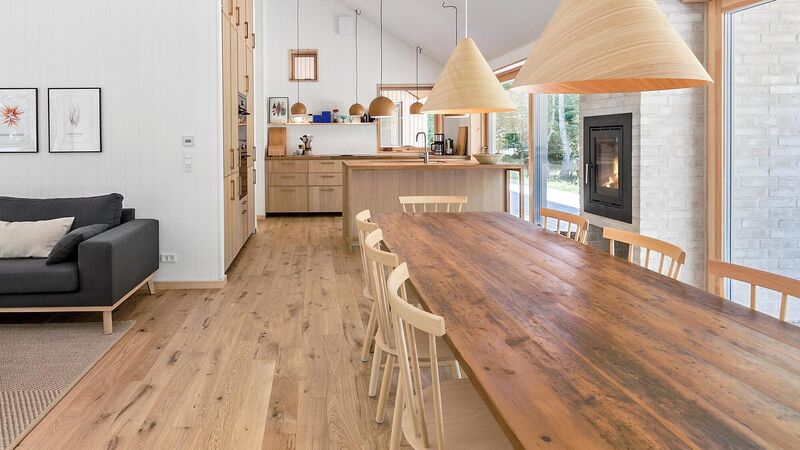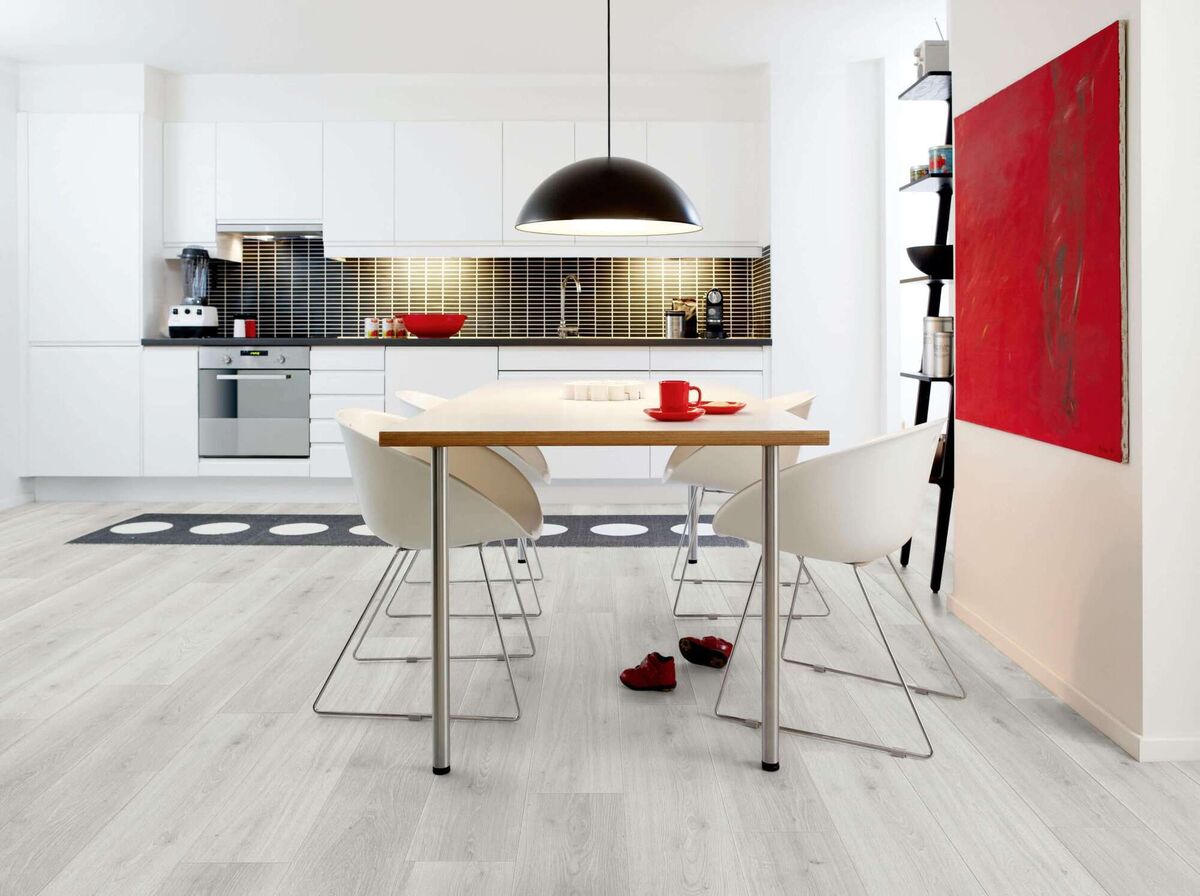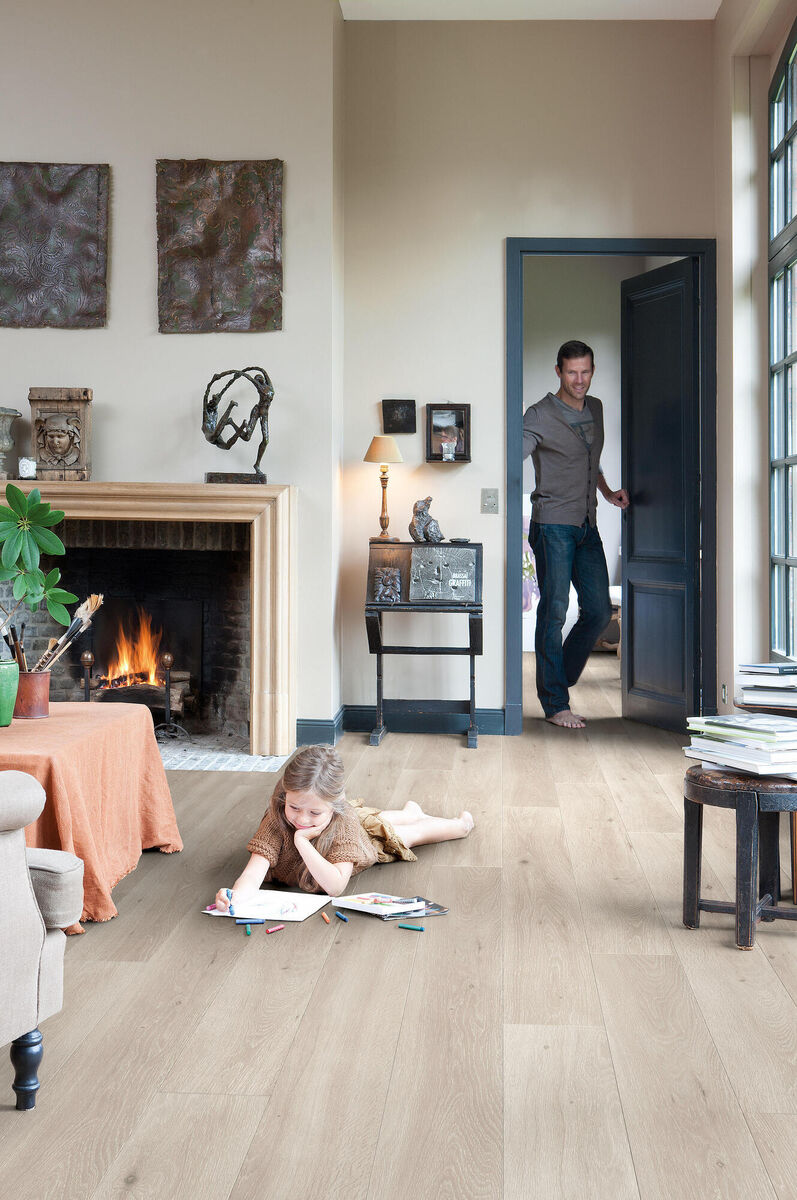Walking the planks: Advice on choosing wood-style flooring for your home

Solid wood has an indicated prestige and expense, but compare its appeal with the structural talents and authentic look delivered by engineered wood flooring. Solid Hardwood. Junckers oak planks from €120-€306 per sq m, Juncker.ie. Cork suppliers including Brooks, brooksonline.ie
Plank style flooring remains a top choice to cover our domestic acres. With the reassuring honesty of a woodgrain, ridiculously easy maintenance that carpet simply cannot match, and a price point to suit everyone: most of us will be faced with a trip to the timber flooring aisle at some point in our build or renovation. Here, we’ll take a look at the divisions of wood-style flooring you will be faced with, including installation, longevity and cost implications that should influence your final selection.
- €50-€220 per sq m ex installation for hardwood, frequently on offer
Solid, hardwood flooring is often presumed to be the most ritzy choice for planks – but that’s being far too simplistic. If you’re considered a solid wood floor, you should be comparing it very closely with the benefits of an engineered wood floor. As suggested by its name, solid wood flooring is quite simply a board that’s a single piece of honest-to-god seasoned timber cut from one species plank.

Some boards in singles, two’s or threes, or parquet - come raw, others are finished, while some are treated (oiled, waxed etc) in situ.
Pricewise, offers on top-tier, solid wood flooring can be startling, for instance, Junckers Black Oak Boulevard planks in a trending Ultra-matt lacquer were recently offered from an Irish supplier at less than €110 per square metre, a saving of almost €95 on their RRP. Check out deals on fabulous HexParket too, junckers.ie. floorstoredirect.ie stocks narrow plank Atlantic Canadian Maple from €72.94, and that’s fully varnished.
Solid wood flooring has the reputation of timeless elegance, toughness and indicated expense. While all these things are true, its two signature benefits are its density, which will dull sound vibration as you walk over it, and the ability to be re-finished time after time (sanded/stained/varnished/painted).

They also repel liquid spills well, and overall can be expected to last decades, re-imagined as other materials are ripped out, and salvaged and recycled for new projects. FSC sourced timber is planet-friendly. The choice of finish to the individual, authentic grain in every board has expanded to include charring, riven textures and hand-honed ripples and distressed chain battering to the boards.
Apart from being the most expensive planks on offer (bar softwoods like deal at around €12 per 4.8M 150 X 22), you may struggle to find reasons to choose solid oak, cherry, walnut or ash over-engineered flooring with a natural top layer and better structural stability. Installation is best left to a professional as your planks or parquet pieces will require careful acclimatising, cutting, nailing and glueing into position. Solid wood planks are not appropriate to kitchens and bathrooms, where pooling water can get under them and warp even a thick floor. UFH can also shrink and buckle this flooring. Get your fitting price in total, to include any finishing work and accessories like trim pieces, underlay, insulation or damp-proofing
- €30 per sq m for 0.6mm veneer click, no sanding possible, to over €120 per sq m for premiere 6mm veneer lines ex. installation
A fantastic product that delivers the authentic aesthetic beauty of real wood and tackles the major issues with a through-wood board. The top face of the board is luxuriant veneer 3mm-15mm thick of wood, set over a core sandwich of 5-7 ply layers running at 90◦ to each other to keep the board level and unmoving in the face of fluctuating humidity in the materials.
Brushed, oiled, bleached or varnished, the price point for the very best engineered wood is comparable to mid-range solid hardwood. For a fresh cut look with an attractive rusticity; go for brushed boards. Look for AC5 commercial rating for a diamond-touch performance to last available even in some cheaper engineered brands. Budget for essential finishing profiles and matching skirting if you fancy it.
Better engineered flooring can be sanded and refinished but not as many times as hardwood. Still, even refreshed twice, you can see they could last half a century with care.

Expect to lose 0.5mm of the surface layer during sanding. They can be laid with an underlay to float over a range of sub-floors including concrete, again vaulting them over the prep required for solid planks. With T&G edges and glueing most are within the capabilities of a confident DIY weekend warrior. With the ability to flex and move without warping, they are better suited to UFH, and come in a vast array of pre-finished colours and textures, indiscernible from solid wood, except for a very slightly more hollow sound under hard heels.
Prices for good engineered flooring can be higher than expected, reaching €120 per metre for birch-ply cores and you get what you pay for in lush, wide planks (260mm) and even 6mm veneers. Like solid wood, engineered wood has a lot of environmentally reactive timber in its make=up, and is a poor choice for high humidity like kitchens and bathrooms.
It only takes a small gap between boards or a nick to the finish to let water in – potentially spoiling areas of your floor. Keep 10% more boards as surplus in case of disaster, as certain products may not be available year to year. Ensure you understand if the floor is fixed to the sub-floor or ‘floated’ – fixed to itself as a raft. Wide boards must be laid over a perfect substrate to keep the joints flush and together.
- From €25-€54 for pricier brands like Pergo, per sq m, ex. installation in quality flooring with a good print and 20-year guarantee
The great, and indeed often surprising pretender of the wood floor family, laminate flooring has little or no actual wood in its visible face. Durable, robust - consider it as a resin textured topcoat glued to a pressed composite wood (dust and fibres) and is around 6mm-12mm thick.
It may be glossy or textured, but no matter how enticing, it’s still only mimicking wood with varying degrees of success using digital print and embossing technology. Laminate is very economical.
Measure your room, then, to get the area in metres square, multiply the length by the width, and allow a small amount for wastage. Set against the square metre of the other contenders, laminate will win hands down. Look for extras like Quick-Step Scratch Guard to protect your investment.
The quality of affordable wood-look laminate flooring has improved out of all recognition in the past 30 years with a variety of figuring and handsome polishes. It can stand up to serious slings and arrows in halls, kitchens, bathrooms, home offices and even work-out rooms.
If you’re determined on wood figuring in the kitchen choose water-resistant laminate and for the bathroom a waterproof laminate, warmer than tile and a doddle to install in a couple of hours. Hand-scraped varieties are ideal for hiding both dirt and minor damage, while gloss types can imitate fossilized wood, marble and ceramics with a metropolitan ease. Laminate floating flooring requires a small expansion space around the perimeter of the room, but with click-lock and clip installation – it’s ideal for DIY projects on a tight budget to slash labour costs.
A thin floating floor may have lesser guarantees and may not carry the UV resistant character of real wood flooring. It’s convincing only at a glance and can give under the foot, revealing its thin construction almost immediately.
Real wood and engineered wood facings have an elastic response to impact, allowing them to not mark at all, or to develop a soft distress that simply adds character.
Plastic coatings in laminate flooring knocked about over time, scuff, fade, chip and crack, an ugly look that cannot be sanded, varnished or otherwise rejuvenated. Wax or repair putty is your only potential fix. Concentrate on foam, polystyrene or wood-fibre underlay (from €8 per sq m) to support your new flooring. Feel will make all the difference to its success and acoustic performance, especially when used upstairs, where it can otherwise tap off the sub-floor when walked on.











